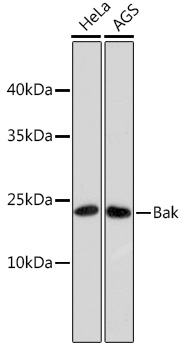Anti-Bak Antibody (CAB10754)
- SKU:
- CAB10754
- Product type:
- Antibody
- Reactivity:
- Human
- Host Species:
- Rabbit
- Isotype:
- IgG
- Antibody Type:
- Monoclonal Antibody
- Research Area:
- Cell Death
Description
| Antibody Name: | Anti-Bak Antibody |
| Antibody SKU: | CAB10754 |
| Antibody Size: | 20uL, 50uL, 100uL |
| Application: | WB |
| Reactivity: | Human |
| Host Species: | Rabbit |
| Immunogen: | Recombinant protein of human Bak |
| Application: | WB |
| Recommended Dilution: | WB 1:500 - 1:2000 |
| Reactivity: | Human |
| Positive Samples: | HeLa, AGS |
| Immunogen: | Recombinant protein of human Bak |
| Purification Method: | Affinity purification |
| Storage Buffer: | Store at -20°C. Avoid freeze / thaw cycles. Buffer: PBS with 0.02% sodium azide, 0.05% BSA, 50% glycerol, pH7.3. |
| Isotype: | IgG |
| Sequence: | Email for sequence |
| Gene ID: | 578 |
| Uniprot: | Q16611 |
| Cellular Location: | Mitochondrion membrane, Single-pass membrane protein |
| Calculated MW: | 16kDa/23kDa |
| Observed MW: | 23kDa |
| Synonyms: | BAK1, BAK, BAK-LIKE, BCL2L7 |
| Background: | The protein encoded by this gene belongs to the BCL2 protein family. BCL2 family members form oligomers or heterodimers and act as anti- or pro-apoptotic regulators that are involved in a wide variety of cellular activities. This protein localizes to mitochondria, and functions to induce apoptosis. It interacts with and accelerates the opening of the mitochondrial voltage-dependent anion channel, which leads to a loss in membrane potential and the release of cytochrome c. This protein also interacts with the tumor suppressor P53 after exposure to cell stress. |
| UniProt Protein Function: | BAK1: In the presence of an appropriate stimulus, accelerates programmed cell death by binding to, and antagonizing the anti- apoptotic action of BCL2 or its adenovirus homolog E1B 19k protein. Low micromolar levels of zinc ions inhibit the promotion of apoptosis. Interacts with BCL2A1. Homodimer. Formation of the homodimer is zinc-dependent. Forms heterodimers with BCL2, E1B 19k protein, and BCL2L1 isoform Bcl-X(L). Interacts with myxoma virus protein M11L. Expressed in a wide variety of tissues, with highest levels in the heart and skeletal muscle. Belongs to the Bcl-2 family. |
| UniProt Protein Details: | Protein type:Membrane protein, integral; Mitochondrial; Endoplasmic reticulum; Apoptosis Chromosomal Location of Human Ortholog: 6p21.3 Cellular Component: cytosol; endoplasmic reticulum; integral to mitochondrial outer membrane; mitochondrial outer membrane; mitochondrion; pore complex Molecular Function:BH domain binding; chaperone binding; heat shock protein binding; identical protein binding; metal ion binding; protein binding; protein heterodimerization activity; protein homodimerization activity Biological Process: aging; apoptosis; B cell apoptosis; B cell homeostasis; B cell negative selection; blood vessel remodeling; brain development; caspase activation via cytochrome c; cell proliferation; cytolysis; DNA damage response, signal transduction resulting in induction of apoptosis; endocrine pancreas development; endoplasmic reticulum calcium ion homeostasis; establishment and/or maintenance of transmembrane electrochemical gradient; limb morphogenesis; mitochondrial fusion; myeloid cell homeostasis; negative regulation of cell proliferation; negative regulation of peptidyl-serine phosphorylation; organ regeneration; positive regulation of apoptosis; positive regulation of proteolysis; post-embryonic camera-type eye morphogenesis; programmed cell death; reduction of endoplasmic reticulum calcium ion concentration; regulation of cell cycle; regulation of mitochondrial membrane permeability; regulation of mitochondrial membrane potential; regulation of protein heterodimerization activity; regulation of protein homodimerization activity; release of cytochrome c from mitochondria; response to drug; response to ethanol; response to fungus; response to gamma radiation; response to hydrogen peroxide; response to mycotoxin; response to organic cyclic substance; response to UV-C; unfolded protein response, activation of signaling protein activity; vagina development |
| NCBI Summary: | The protein encoded by this gene belongs to the BCL2 protein family. BCL2 family members form oligomers or heterodimers and act as anti- or pro-apoptotic regulators that are involved in a wide variety of cellular activities. This protein localizes to mitochondria, and functions to induce apoptosis. It interacts with and accelerates the opening of the mitochondrial voltage-dependent anion channel, which leads to a loss in membrane potential and the release of cytochrome c. This protein also interacts with the tumor suppressor P53 after exposure to cell stress. [provided by RefSeq, Jul 2008] |
| UniProt Code: | Q16611 |
| NCBI GenInfo Identifier: | 2493274 |
| NCBI Gene ID: | 578 |
| NCBI Accession: | Q16611.1 |
| UniProt Secondary Accession: | Q16611,Q6I9T6, Q92533, C0H5Y7, |
| UniProt Related Accession: | Q16611 |
| Molecular Weight: | 16,872 Da |
| NCBI Full Name: | Bcl-2 homologous antagonist/killer |
| NCBI Synonym Full Names: | BCL2 antagonist/killer 1 |
| NCBI Official Symbol: | BAK1 |
| NCBI Official Synonym Symbols: | BAK; CDN1; BCL2L7; BAK-LIKE |
| NCBI Protein Information: | bcl-2 homologous antagonist/killer |
| UniProt Protein Name: | Bcl-2 homologous antagonist/killer |
| UniProt Synonym Protein Names: | Apoptosis regulator BAK; Bcl-2-like protein 7; Bcl2-L-7 |
| UniProt Gene Name: | BAK1 |
| UniProt Entry Name: | BAK_HUMAN |




![Anti-Bak Antibody (CAB18002)[KO Validated] Anti-Bak Antibody (CAB18002)[KO Validated]](https://cdn11.bigcommerce.com/s-39x6lpnvxv/images/stencil/590x590/products/30262/28451/anti-bak-antibody-cab18002ko-validated__71022__40435.1644317034.jpg?c=1)




